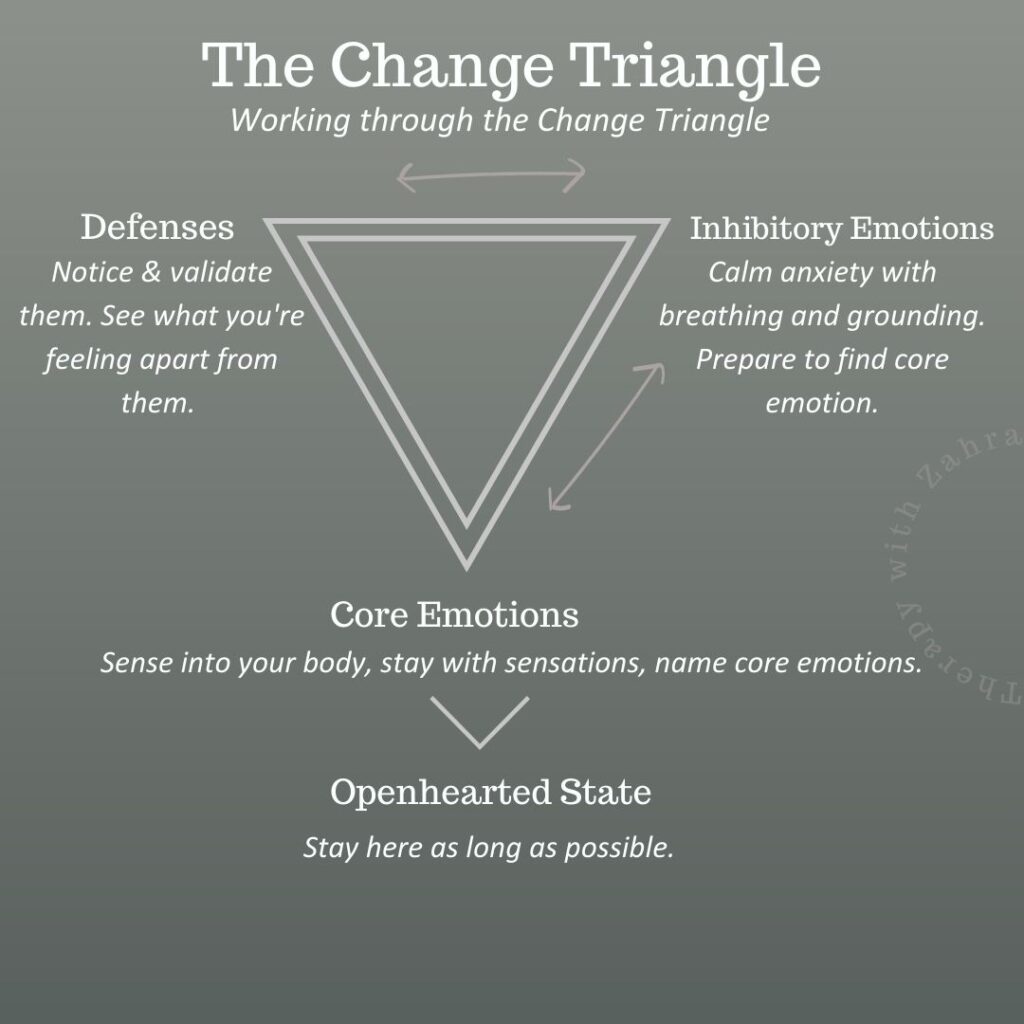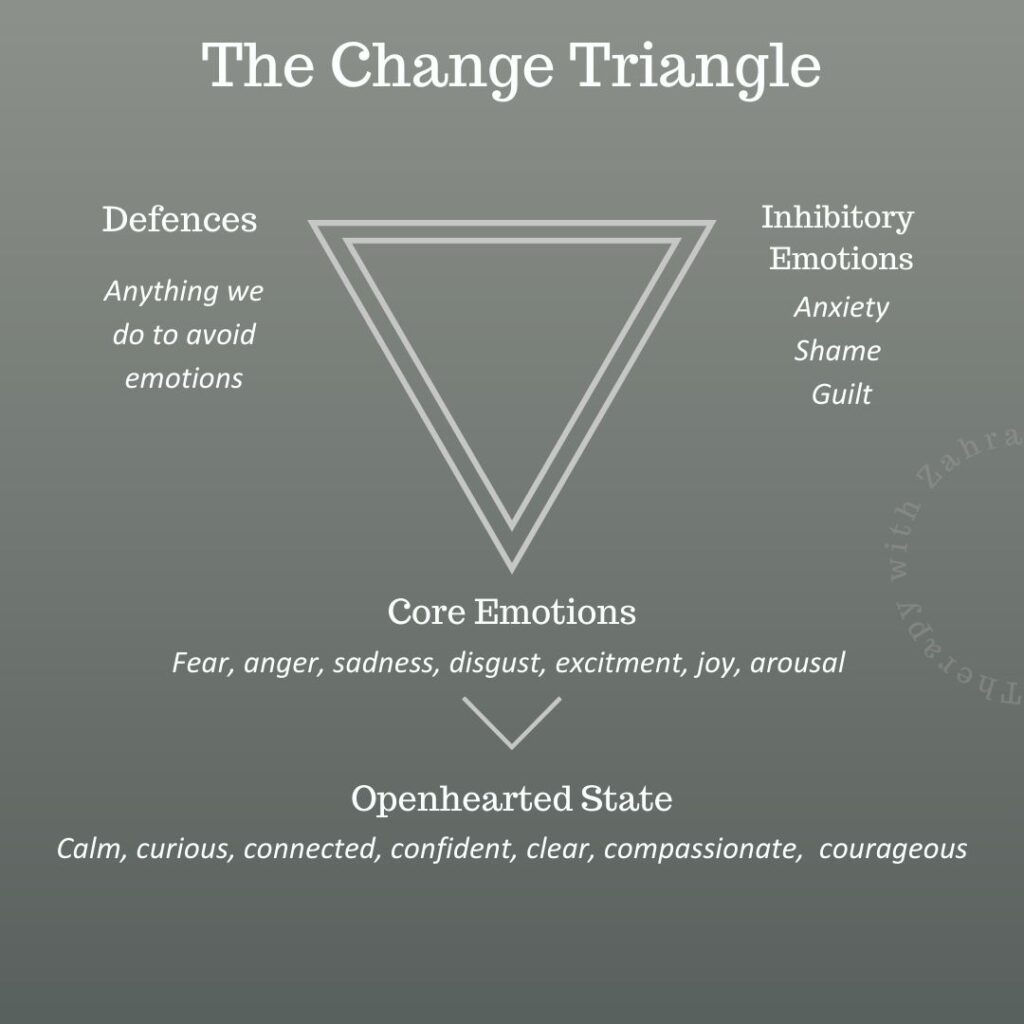Our emotions significantly influence our reactions to events, how we interact with others, and our self-perception. But understanding these emotions can often be like trying to decipher a foreign language. The Change Triangle, for those unfamiliar, is a framework designed to clarify our emotional responses and steer us toward healthier emotional well-being.
What is the Change Triangle?
The concept of the Change Triangle is rooted in Accelerated Experiential Dynamic Psychotherapy (AEDP). AEDP is a therapeutic approach that emphasizes emotional experiences, tapping into our innate healing capacities. Within this framework, the Change Triangle helps individuals understand and process their emotions.
The Change Triangle is structured around three key emotional states:
1. Defense
2. Inhibitory Emotions
3. Core Emotions
Let’s delve into these concepts one by one:
1. Defence: The Guardian
Despite their negative connotations, defences are the mind’s way of shielding us from intense or discomforting emotions. Manifestation of defences may include vagueness, sarcasm, perfectionism, numbing, judging self or others. While these defences may offer temporary relief and can be useful in the short term (like holding back tears in a professional setting), overreliance on these defences can disconnect us from ourselves and others.
2. Inhibitory Emotions: The Suppressors
These emotions, including anxiety, guilt, and shame, mask our core emotions. They usually emerge to maintain relational harmony or when core emotions become too overwhelming. For example, if 5-year-old John is met with anger or indifference every time he expresses sadness, John will eventually learn to hide his sadness. Thus, suppressing his sadness helps him preserve his connection with his caregiver. In adulthood, every time his core emotion of sadness pushes up for expression, inhibitory emotions suppress his sadness creating tension. If these suppressions aren’t addressed, they can lead to enduring physical and psychological consequences.
3. Core Emotions: The Truth North
At the triangle’s base are our core emotions: joy, anger, sadness, disgust, fear, excitement, and arousal. These Core Emotions, essential for our well-being, are our barometers indicating safety, needs, pleasures, and aversions. They also arise from the mid-brain and operate beyond our conscious control. We do not choose to experience them; they simply happen. When we are attuned to these core emotions, confronting them directly, we operate optimally, feeling more vibrant and interconnected.
Regularly addressing our defences and inhibitory emotions allows us to achieve an openhearted state. This state, as described by Richard Schwartz1, is a grounded inner peace where we feel in tune with our emotions and environment. Some might naturally exist in this state, while others might need the guidance of tools like the Change Triangle. Regardless of the starting point, this tool can illuminate the path to emotional clarity and well-being.
The Change Triangle in Real Life

Let’s take an example: Sarah has always been anxious about public speaking. Using the Change Triangle, she would sense her position on It. In this case, she realized anxiety (an inhibitory emotion) masked a core emotion: fear of judgment. She worked on addressing the anxiety using breathing techniques. Through the continuous practice of noticing where she was on the triangle, sensing her body, naming her core emotion and moving to an openhearted state, she gradually became more comfortable speaking in public.
Utilizing the Change Triangle Outside of Therapy
While therapy may be incredibly helpful, the Change Triangle is valuable even on its own. Here is how you can explore its benefits independently:
- Self-awareness: Begin by frequently pausing to reflect on your feelings and emotions throughout the day. Ask, “Where am I on the Change Triangle right now?” By identifying whether you are in defence, feeling inhibitory emotions, or experiencing core emotions, you can develop understanding of your emotional state and work through the steps using the image above.
- Journaling: Dedicate a few minutes daily to jot down your emotions and potential triggers. Over time, patterns may emerge, giving you insights into recurring defences or suppressed core emotions.
- Mindfulness and Meditation: These practices can help you maintain awareness of your emotional state. They train the brain to be present, allowing for recognition of where you stand on the Change Triangle at any given moment.
- Educate Yourself: There are numerous resources online, including articles, videos, and webinars about the Change Triangle. The more you learn, the more adept you will become at navigating it. Hilary Jacobs Hendel2 has a fantastic book the breaks down the concepts of the Change Triangle in a simplified manner. Her book also contains many examples and practical techniques.
- Seek Support: Discuss your journey with trusted friends, family, or peer groups on similar paths. Their insights can offer fresh perspectives and validate your emotions..
Conclusion
I have found the visual depiction of the Change Triangle handy when overwhelmed by strong emotions. Visualizing the Change Triangle in my mind’s eye helps me navigate my thoughts and sensations without feeling overwhelmed. As I continue to master the Change Triangle in my journey, I have noticed I am not only keenly aware of my own defences and inhibitory emotions but those of others.
What are your thoughts about the Change Triangle as a possible tool to your emotional journey? What are some areas that resonate with you? Looking to integrate the Change Triangle into your emotional journey? Schedule a session today.
Until next time,
Zahra
- Richard Schwartz: Developed Internal Family Systems (IFS) therapy. ↩︎
- “IIt’s Not Always Depression: Working the Change Triangle to Listen to the Body, Discover Core Emotions, and Connect to Your Authentic Self by Hilary Jacobs Hendel. Find her book here ↩︎


